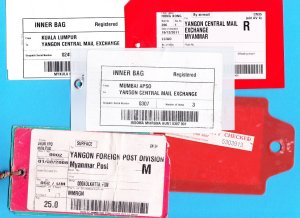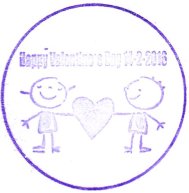Something from the fringes of philately – some modern mail bag labels, thanks to a kind gift from Myanmar. These need a bit of study (when I can find the time) to make full sense of them, but here’s a sample of some different types, in case anyone’s interested.
First, some foreign incoming labels from about 1990, surface mail and (the two top right) registered. The former are clearly standardised by UPU regulation, and all are in card, with proper holes for ties. I imagine the registered labels are from inner bags, within the main bag. (Click all images to enlarge.)
The arrival of the barcode has changed the look of these more recent examples, surface, air and registered, and the standardisation of design seems more thorough. Interesting to note that in the destination code – MMRGN – the country title, MM for Myanmar, recognises the new form while the city name, RGN for Rangoon, still does not. The big plastic label has a Thai security checked sticker on the back – something for civil censorship collectors.
Next, some domestic EMS (Expedited, or Express Mail Service) bag labels from 2000. The one on the left has a red marking reading “Airport Security / checked / Myeik”. The others are from Mandalay (marked as a “green bag”), Kalaw and Salin, all to Yangon.
Now some more recent inland labels, from 2010 and 2011 – the most interesting of the lot, in my opinion. Only one pukka card label here; the rest are random pieces of card and folded paper, some attached to the bags with string and sealing wax. The postmarks of the sending offices are clear enough, and some of the abbreviations are simple enough – “YAN RL BN 11” for registered letters to Yangon, bag number 11, for instance – but others will need a bit of deciphering.
Finally, to bring things up to date, the plastic security ties now used by Myanmar Post, cut and discarded when the bags are opened. There are thousands of similar ties on sale online, all, as far as I can see, made in China, but I haven’t yet been able to identify the manufacturer of these. All that is now shown is the post code of the sending office. (Post codes in Myanmar relate to post offices only. Therein lies a tale, but perhaps for another time.)











